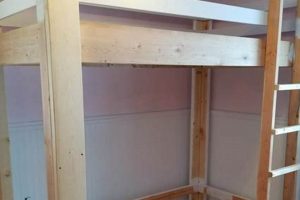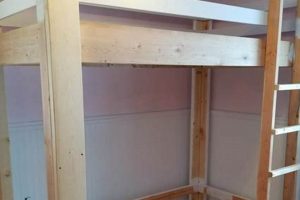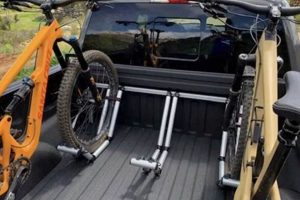A self-constructed cargo platform for pickup trucks represents a cost-effective and customizable alternative to commercially manufactured options. These individualized solutions typically involve utilizing materials such as wood, metal, or composite materials to create a structure within the truck’s bed, serving to organize, protect, or enhance its functionality. For instance, a user might construct a system of drawers and shelving for tool storage or a platform to elevate cargo above the wheel wells.
The primary advantage of such an endeavor lies in its potential for significant cost savings compared to purchasing pre-fabricated units. Furthermore, the ability to tailor the design to specific needs and preferences offers unparalleled flexibility. Historically, individuals have crafted these solutions to adapt their vehicles to various trades, hobbies, and personal requirements, creating solutions unavailable or excessively expensive on the open market. This approach fosters self-reliance and promotes resourceful adaptation of existing resources.
The subsequent sections will explore the key considerations for undertaking such a project, including material selection, design principles, construction techniques, and safety precautions. Careful planning and execution are paramount to ensuring a durable, functional, and secure cargo solution for the vehicle.
Essential Considerations for Constructing a Truck Cargo Platform
Implementing a self-fabricated solution for a pickup truck’s cargo area requires diligent planning and execution. The following recommendations aim to guide individuals through critical aspects of the process, ensuring both structural integrity and user safety.
Tip 1: Material Selection: The selection of materials directly impacts the project’s durability and longevity. Consider treated lumber for weather resistance or steel for enhanced strength. Evaluate load-bearing capacity and resistance to environmental factors before making a final decision.
Tip 2: Design and Planning: Prior to construction, develop a comprehensive design that accounts for the truck bed’s dimensions, desired functionality, and weight distribution. Utilize CAD software or detailed sketches to visualize the final product and identify potential issues early on.
Tip 3: Secure Fastening: Proper fastening is crucial for structural integrity. Employ high-quality bolts, screws, and adhesives specifically designed for the chosen materials. Ensure that all connections are adequately reinforced to withstand the stresses of transport.
Tip 4: Weatherproofing: To protect the cargo platform from the elements, apply a durable sealant or coating. This will prevent water damage, corrosion, and premature deterioration, extending the lifespan of the structure.
Tip 5: Weight Distribution: Distribute the weight of the cargo evenly across the platform to avoid overloading specific areas. This will prevent structural failure and maintain the truck’s handling characteristics.
Tip 6: Safety Considerations: Prioritize safety during construction and use. Wear appropriate safety gear, such as eye protection and gloves. Ensure that the cargo platform is securely anchored to the truck bed to prevent movement during transit.
Tip 7: Legal Compliance: Research and adhere to all relevant local and state regulations regarding vehicle modifications. Ensure that the cargo platform does not obstruct visibility or interfere with the vehicle’s safety systems.
Careful adherence to these recommendations will significantly enhance the safety, durability, and functionality of a self-constructed truck cargo platform, maximizing its value and minimizing potential risks.
The subsequent section will delve into specific construction techniques and provide detailed instructions for creating a functional and aesthetically pleasing cargo solution.
1. Material Load Capacity
Material load capacity is a critical determinant of the functionality and safety of any self-constructed truck cargo platform. This parameter defines the maximum weight the structure can withstand without experiencing deformation or failure. The choice of materials directly influences the overall load capacity. For instance, a platform constructed from pressure-treated lumber will possess a different load-bearing capability compared to one fabricated from steel. Exceeding the specified material load capacity can lead to structural compromise, potentially resulting in damage to the vehicle, the cargo being transported, or even posing a safety risk to other motorists.
Consider a scenario where an individual fabricates a platform for transporting landscaping materials. If the chosen wood is not rated for the combined weight of soil, plants, and equipment, the platform may sag or collapse under the load. Conversely, a properly engineered steel frame, while potentially more expensive and requiring specialized fabrication skills, offers a significantly higher load capacity and increased durability. Therefore, understanding the properties of different materials and accurately calculating the anticipated load is essential during the design phase.
Ultimately, material load capacity serves as a non-negotiable constraint in the execution of a self-built truck cargo bed. Accurate assessment and appropriate material selection are critical for ensuring both the longevity and safety of the customized truck configuration. Ignoring this parameter introduces unacceptable risks that directly undermine the project’s viability and purpose.
2. Structural Integrity
Structural integrity forms the bedrock of any safe and effective cargo platform for pickup trucks. The ability of the assembly to withstand anticipated loads, stresses induced by vehicle movement, and environmental factors directly determines its long-term utility and the safety of both the vehicle and its occupants. Insufficient structural integrity in a self-constructed truck bed can lead to catastrophic failure, resulting in damaged cargo, compromised vehicle handling, and increased risk of accidents. For example, if the frame securing a toolbox within the bed buckles due to inadequate welding or material selection, the unsecured toolbox may shift during transit, potentially causing a collision or obstructing the driver’s view.
The principles of structural engineering must inform the design and construction phases. Material selection plays a crucial role; using lumber with inadequate load-bearing capacity or metal with insufficient tensile strength compromises the entire structure. Likewise, proper fastening techniques, such as employing appropriately sized and spaced bolts or utilizing welds that meet industry standards, are essential to ensure the secure transfer of loads between components. Furthermore, understanding the distribution of weight and stress points within the bed is critical to reinforcing areas prone to failure. A cargo platform intended to transport heavy machinery, for instance, requires significantly more robust structural elements than one designed solely for light-duty purposes.
In summary, structural integrity is not merely a desirable attribute but a fundamental requirement for a safe and functional truck cargo solution. A lack of attention to sound engineering principles during the fabrication process poses substantial risks. Rigorous planning, appropriate material selection, and meticulous execution are therefore paramount to realizing a durable and reliable addition to the pickup truck.
3. Weather Resistance
Weather resistance is a paramount consideration in the design and construction of a self-fabricated truck bed, directly impacting its longevity and functionality. Exposure to environmental elements such as rain, snow, sunlight, and temperature fluctuations can degrade unprotected materials, leading to premature failure of the structure. The consequences of neglecting weather resistance range from cosmetic imperfections to structural compromises, potentially endangering cargo and vehicle safety. For example, untreated wooden platforms are susceptible to rot and decay, weakening their ability to support heavy loads. Similarly, unprotected metal components may corrode, diminishing their strength and structural integrity. The choice of materials, construction techniques, and protective coatings are therefore crucial in mitigating these risks.
The practical application of weather-resistant strategies involves several key steps. Selecting naturally durable materials, such as pressure-treated lumber or marine-grade plywood, provides inherent protection against moisture and insect damage. Applying waterproof sealants and paints to exposed surfaces creates a barrier against water penetration, preventing rot and corrosion. Utilizing rust-resistant fasteners, such as stainless steel bolts and screws, minimizes the risk of structural failure due to corrosion. Furthermore, incorporating drainage channels in the design allows water to escape, preventing accumulation and subsequent damage. The efficacy of these strategies directly translates to the extended lifespan and reliable performance of the truck cargo platform. Real-world application includes regularly inspecting and maintaining any coating to prevent deterioration that can lead to water and rot. Another example is avoiding direct metal to metal contact which can lead to galvanic corrosion.
In conclusion, weather resistance is not merely an aesthetic consideration but a fundamental engineering requirement for a custom-built truck bed. The selection of appropriate materials, the implementation of protective measures, and ongoing maintenance are essential for ensuring the durability, safety, and long-term value of the structure. Neglecting weather resistance exposes the platform to premature degradation, ultimately undermining its intended purpose and potentially leading to costly repairs or replacements. The practical significance of understanding and addressing this aspect is therefore undeniable.
4. Secure Anchoring
Secure anchoring constitutes a critical safety component of any self-constructed truck cargo platform. Improperly secured structures pose a significant risk, potentially leading to shifting cargo, compromised vehicle handling, and, in severe cases, accidents. The connection between secure anchoring and a do-it-yourself truck bed is causal: inadequate anchoring directly results in instability and potential harm. Conversely, robust anchoring systems ensure that the customized truck bed remains firmly affixed to the vehicle, preventing displacement during sudden stops, sharp turns, or uneven terrain traversal. Real-world examples include scenarios where unsecured toolboxes or construction materials have shifted during transit, causing damage to the vehicle and creating hazardous road conditions for other drivers. This underscores the critical need for effective anchoring solutions.
Practical application of secure anchoring principles involves several key considerations. The type of anchoring hardware selected must be appropriate for both the materials used in the platform construction and the truck bed itself. Heavy-duty bolts, straps, or tie-down systems are generally recommended, with specific choices dependent on the weight and dimensions of the cargo platform. Furthermore, the anchoring points on the truck bed must be structurally sound and capable of withstanding the applied forces. Utilizing existing factory-installed tie-down points or reinforcing weak areas with additional metal bracing can enhance the overall security of the system. Consistent inspection of the anchoring hardware and tightening of bolts as needed is also essential for maintaining its effectiveness over time.
In conclusion, secure anchoring is not an optional feature but an indispensable element of a safe and functional self-constructed truck bed. Prioritizing robust anchoring techniques mitigates the risks associated with cargo shifting and ensures the stability of the vehicle during operation. Neglecting this aspect can have severe consequences, underscoring the practical significance of understanding and implementing effective securement solutions. Adherence to established engineering principles and safety guidelines is paramount in realizing a secure and reliable customized truck cargo platform.
5. Custom Dimensions
The inherent advantage of a self-constructed truck cargo platform lies in its ability to accommodate specific needs through custom dimensions. This adaptability allows for a precisely tailored solution, unlike standardized commercial options. The direct consequence of accurately implementing custom dimensions is maximized utility and efficiency within the vehicle. Improper measurements or disregard for spatial limitations can lead to a dysfunctional platform, negating the benefits of the project. Consider, for example, a tradesperson requiring a specific configuration of shelving and drawers to house tools; accurately measured custom dimensions are essential for ensuring that all equipment fits securely and is readily accessible.
Practical applications of custom dimensions extend to various scenarios. A carpenter might design a platform with specific compartments for lumber storage, preventing shifting during transit. An outdoor enthusiast could construct a raised platform with integrated storage, creating a sleeping area while maximizing cargo capacity. In each instance, the ability to specify dimensions precisely ensures optimal utilization of available space and caters to the unique requirements of the user. Further examples include using a specific height to align with other equipment for ease of transfer, creating an angled platform to efficiently store irregularly shaped items, or maximizing floor space while avoiding obscuring the view through the rear window.
Ultimately, the integration of custom dimensions is crucial to the success of a “diy truck bed” project. While standardized commercial options offer convenience, the capacity to tailor dimensions to specific needs creates unparalleled versatility. The challenges lie in the precision required during the measurement and construction phases. However, the resultant benefits in terms of optimized space utilization, enhanced functionality, and personalized design render the effort worthwhile, solidifying custom dimensions as a cornerstone of self-fabricated truck cargo solutions.
Frequently Asked Questions
This section addresses common inquiries and concerns regarding the design, construction, and maintenance of self-fabricated truck cargo platforms. The information provided is intended to promote safety and inform decision-making.
Question 1: What are the primary considerations when selecting materials for a homemade truck bed?
Material selection should prioritize strength, durability, and resistance to environmental factors. Treated lumber, steel, and aluminum represent viable options, each possessing unique properties that influence load capacity, weight, and longevity. The intended use and budget constraints should also factor into the decision.
Question 2: How can one ensure the structural integrity of a self-constructed truck bed?
Structural integrity is achieved through careful design, appropriate material selection, and robust fastening techniques. Proper joinery, reinforcement of stress points, and adherence to engineering principles are essential for creating a stable and secure platform. Consulting with a qualified professional is advisable for complex designs or heavy load applications.
Question 3: What measures should be taken to protect a homemade truck bed from weather damage?
Weatherproofing strategies include applying waterproof sealants, paints, or coatings to exposed surfaces. The use of corrosion-resistant fasteners and the incorporation of drainage channels are also recommended. Regular inspection and maintenance are necessary to prevent deterioration and extend the lifespan of the structure.
Question 4: How should a self-constructed truck bed be securely anchored to the vehicle?
Secure anchoring requires the use of appropriate hardware, such as heavy-duty bolts, straps, or tie-down systems. Anchoring points on the truck bed must be structurally sound and capable of withstanding the applied forces. Regular inspection and tightening of fasteners are essential for maintaining the integrity of the anchoring system.
Question 5: Are there legal regulations governing the construction and use of homemade truck beds?
Local and state regulations may apply to vehicle modifications, including the construction of truck beds. It is imperative to research and comply with all relevant laws to ensure that the modifications do not violate safety standards or compromise the vehicle’s compliance with regulatory requirements. Failure to comply can result in fines or legal penalties.
Question 6: What safety precautions should be observed during the construction and use of a homemade truck bed?
Safety precautions include wearing appropriate personal protective equipment, such as eye protection and gloves, during construction. Ensuring that the cargo platform is securely anchored and that the load is evenly distributed is crucial for preventing accidents. Regular inspection and maintenance are necessary to identify and address potential hazards.
These FAQs provide a foundation for understanding the essential considerations involved in building a truck cargo platform. However, individual circumstances may necessitate further research and consultation with qualified professionals.
The following section will explore case studies of successful “diy truck bed” projects, providing practical examples and insights.
Concluding Remarks on Self-Constructed Truck Cargo Platforms
This exploration has detailed essential aspects of designing, constructing, and maintaining a “diy truck bed.” Material selection, structural integrity, weather resistance, secure anchoring, and custom dimensions were examined as crucial determinants of a successful project. Addressing frequently asked questions further clarified safety protocols and regulatory considerations. Ultimately, informed decision-making, rigorous planning, and meticulous execution are paramount to achieving a functional and reliable self-fabricated cargo solution.
The potential benefits of a customized truck cargo platform are undeniable, offering cost savings and tailored functionality. However, neglecting established engineering principles and safety guidelines poses substantial risks. Therefore, thorough research, careful planning, and diligent execution are essential to realize the benefits of a “diy truck bed” while mitigating potential hazards. Future innovation in materials and construction techniques will undoubtedly further enhance the possibilities for creating safe and efficient self-fabricated truck cargo solutions.







